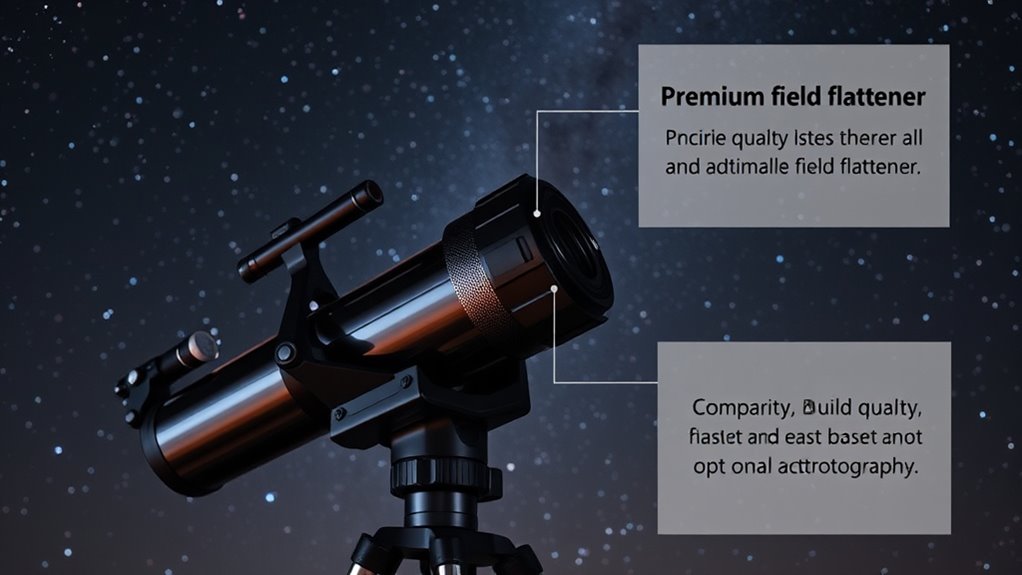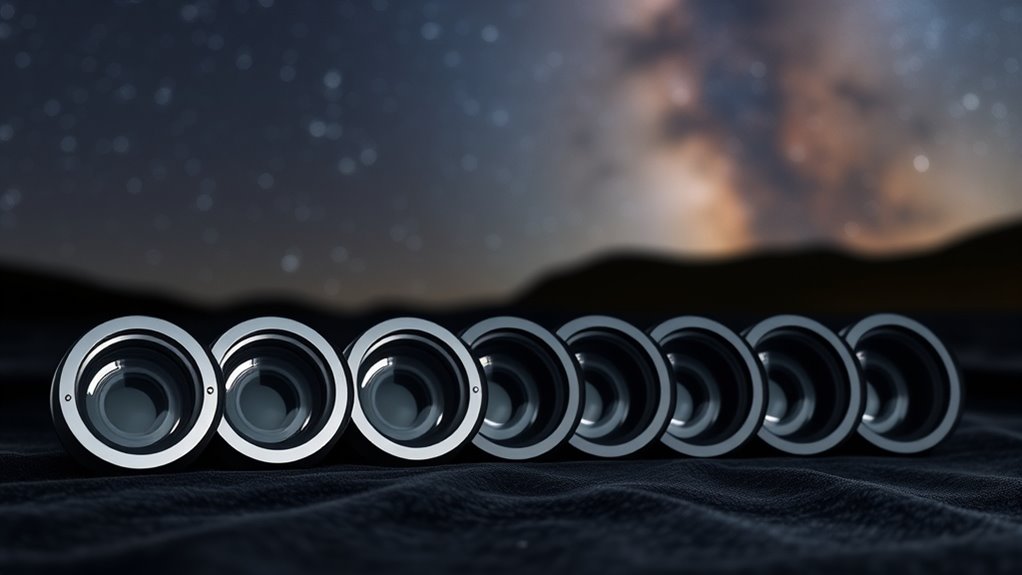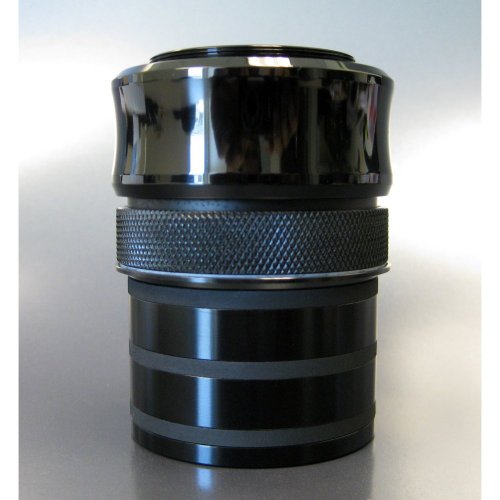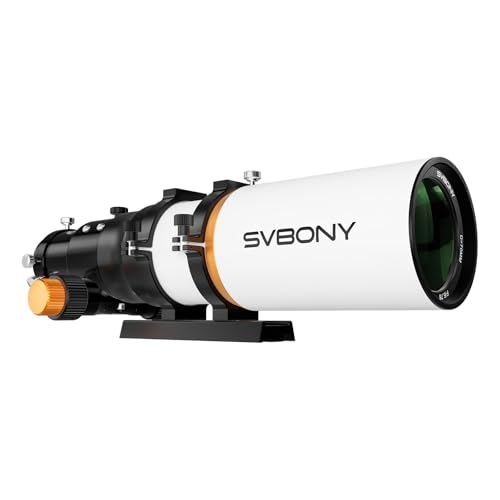If you’re looking to enhance your refractor telescope setup, I recommend checking out the 15 best field flatteners, which correct edge distortion and improve star sharpness across the entire field of view. These accessories improve image quality, contrast, and reduce coma, making your astrophotos more professional and enjoyable. I’ve gathered options like Explore Scientific, SVBONY, and HOTECH models, each suited for different focal ratios. Keep exploring to find the best fit for your stargazing adventures.
Key Takeaways
- The article outlines top field flatteners designed for refractor telescopes, improving image flatness and reducing star distortion.
- It details optical features like multi-coated lenses, compatibility with focal ratios f/4–f/8, and ease of installation.
- Specific models such as Explore Scientific and SVBONY offer various benefits, including focal reduction and high-quality correction.
- Key considerations include correct spacing, build quality, size, weight, and compatibility with existing telescope accessories.
- The guide emphasizes how these flatteners enhance astrophotography, providing sharper, distortion-free images across the entire field.
Explore Scientific Field Flattener for Refractor Telescopes
If you’re looking to improve your astrophotography with refractor telescopes, the Explore Scientific Field Flattener is an excellent choice, especially for those using focal ratios between f/5 and f/7. It reduces star distortion caused by field curvature, ensuring sharp, high-quality images across the entire frame. Easy to install with a T-ring thread and requiring just 55mm (+/- 2mm) of spacing, it’s compatible with many telescopes in this focal range. Its fully multi-coated optical glass maximizes light transmission, enhancing contrast and detail. Whether capturing planets, nebulae, or star clusters, this flattener helps you achieve crisp, professional-looking astrophotos.
Best For: astrophotographers using refractor telescopes with focal ratios between f/5 and f/7 seeking to improve image sharpness and reduce star distortion across the entire field of view.
Pros:
- Effectively minimizes star distortion caused by field curvature for sharper images
- Easy to install with standard T-ring thread and precise 55mm spacing requirement
- Fully multi-coated optical glass maximizes light transmission, contrast, and detail
Cons:
- Compatible only with telescopes in the f/5 to f/7 focal ratio range
- Requires careful spacing adjustment (55mm +/- 2mm) for optimal performance
- May not be suitable for very fast or slow focal ratios outside the specified range
SVBONY SV193 Focal Reducer for Telescopes
The SVBONY SV193 Focal Reducer is an excellent choice for astrophotographers aiming to expand their telescope’s field of view and reduce exposure times. Designed for refractor telescopes like the SV503 80mm F7 ED, it cuts focal length by 20%, brightening images and broadening the view. Compatible with full-frame cameras and supporting 2-inch filters, it helps minimize light pollution and vignetting. The device maintains a flat field, ensuring sharp stars across the frame, especially on advanced refractors. While some users report minor star distortion or coating issues, proper spacing and handling can yield impressive, wide-field astrophotography results.
Best For: Amateur astrophotographers using refractor telescopes like SV503 80mm F7 ED seeking to expand their field of view and reduce exposure times.
Pros:
- Broadens field of view and brightens images by reducing focal length by 20%
- Compatible with full-frame cameras and supports 2-inch filters for light pollution reduction
- Maintains a flat field with minimal star distortion when used properly
Cons:
- Some users experience star distortion, particularly at the edges with small sensors or CCD cameras
- Potential issues with optical coating defects or mechanical instability
- Requires precise spacing (around 55mm for CCDs) for optimal performance, which can be challenging to achieve
SVBONY SV209 Field Flattener, 0.8X Focal Reducer for Telescopes
For astrophotographers seeking sharper, flatter images across their entire field of view, the SVBONY SV209 Field Flattener, 0.8X focal reducer, stands out as an excellent choice. Designed for the SV550 122mm f/7 apo refractor, it corrects field curvature and widens the view, turning an 854mm focal length into 683.2mm at f/5.6. This increases imaging speed and covers DSLR or CCD chips with sharp, round stars from edge to edge. Made from high-quality materials, it’s straightforward to install, although precise backspacing is essential for ideal results. Overall, it greatly improves astrophotography clarity while maintaining stability during use.
Best For: astrophotographers using the SV550 122mm f/7 apo refractor seeking to achieve sharper, flatter images across their entire field of view with improved focus and image quality.
Pros:
- Corrects field curvature for uniformly sharp stars from edge to edge across DSLR and CCD sensors
- Widens the field of view by reducing focal length from 854mm to 683.2mm, increasing imaging speed
- Made from high-quality materials, ensuring durability and stable attachment during astrophotography sessions
Cons:
- Precise backspacing is critical; small measurement discrepancies can affect focus and image quality
- Some users report difficulty achieving perfect focus at the edges despite correct extension tube adjustments
- Initial manufacturing variations, such as coating flaking, may require quality checks or exchanges
HOTECH SCA 2 Inch Field Flattener for Refractor Telescopes
Offering a fully multi-coated two-element lens, the HOTECH SCA 2 Inch Field Flattener delivers bright, sharp images across entire fields, making it ideal for astrophotographers aiming for high-quality, flat-field captures. It’s compatible with f5 to f8 refractor telescopes and features a built-in 2” filter thread and T-ring thread, accommodating all 35mm cameras. Designed for precise camera alignment with compression and rubber rings, it ensures ideal image quality and stability. Its multi-coated lens enhances light transmission, resulting in clearer, brighter images. With a strong customer rating and long-standing reputation, this flattener is a reliable choice for achieving professional-level astrophotography.
Best For: astrophotographers using f5 to f8 refractor telescopes seeking sharp, flat-field images for high-quality astrophotography.
Pros:
- Fully multi-coated two-element lens for enhanced light transmission and image clarity
- Compatible with a wide range of 35mm cameras and features built-in filter and T-ring threads
- Designed for precise camera alignment, ensuring stable and accurate positioning for optimal imaging
Cons:
- May require careful setup to ensure perfect camera alignment and focus
- Slightly higher cost compared to basic field flatteners, reflecting its quality features
- Compatibility limited to refractor telescopes within f5 to f8 range, not suitable for other types of telescopes
SVBONY Focal Reducer and Field Flattener for SV503 Telescope
If you’re looking to improve your astrophotography with the SV503 telescope, the SVBONY Focal Reducer and Field Flattener stands out as an excellent choice. It offers 0.8x focal reduction and field flattening, creating wider views with sharper star points. Made with durable, multi-coated optics and a lightweight aluminum body, it reduces weight without sacrificing image quality. The reducer ensures no distortion at the edges, producing crisp, dazzling celestial photos. Compatibility is straightforward with standard threads and connections, though you may need extension tubes for proper focus at 55mm backfocus. Overall, it’s a solid upgrade for enhancing your wide-field imaging.
Best For: amateur and advanced astrophotographers seeking to enhance wide-field celestial imaging with sharper star points and reduced distortion.
Pros:
- Provides 0.8x focal reduction and field flattening for wider, more detailed sky views
- Made with durable multi-coated optics and lightweight aluminum construction for high image quality and portability
- Ensures no distortion at the edges, producing crisp, dazzling celestial photos
Cons:
- May require removal of the nose piece and use of extension tubes for proper focus at 55mm backfocus
- Compatibility depends on verifying threading and extension tube requirements for specific camera setups
- Some users might experience challenges focusing at certain distances or with specific accessories
SVBONY SV503 Refractor Telescope for Astrophotography
The SVBONY SV503 Refractor Telescope stands out as an excellent choice for astrophotographers seeking sharp, wide-field images with minimal post-processing. Its built-in field flattener guarantees distortion-free views across the entire frame, perfect for deep-sky objects like galaxies and nebulae. The 70mm aperture at F/6.78, combined with ED glass, delivers bright, true-to-life colors and minimal chromatic aberration. Its high-quality optics, similar to premium APO scopes, produce crisp images, while the sturdy build and smooth dual-speed focuser make focusing precise and straightforward. Overall, it’s a versatile, reliable scope ideal for capturing stunning astrophotos with ease.
Best For: amateur astronomers and astrophotographers seeking a portable, high-quality refractor telescope for wide-field deep-sky imaging and planetary observation.
Pros:
- Excellent flat-field correction with minimal distortion across the entire frame
- Bright, sharp images with true-to-life colors thanks to ED glass and high optical quality
- Smooth dual-speed focuser and sturdy build enhance ease of use and stability
Cons:
- Slight residual halos around very bright stars which may require post-processing
- Limited aperture size may restrict detailed planetary observation compared to larger scopes
- Compatibility with accessories like filters or larger mounts may require additional adapters
Astromania 2 Field Flattener for Astronomy Photos
The Astromania 2 Field Flattener is an excellent choice for astrophotographers seeking sharp, edge-to-edge images in their refractor telescope setups. It’s designed for telescopes with focal ratios from f4 to f8 and features M48 threading for full aperture illumination at 2 inches back focus. Its multi-coated lenses enhance clarity and contrast, ensuring pin-sharp stars across the entire field, especially at the edges. Weighing just 8.8 ounces, it’s compact and lightweight, making it easy to handle during sessions. Since its release in May 2022, it’s become popular for reducing field curvature and improving image quality in astrophotography.
Best For: astrophotographers using refractor telescopes with focal ratios from f4 to f8 who want sharp, edge-to-edge images with minimized field curvature.
Pros:
- Ensures perfect image flatness for high-quality astrophotography
- Multi-coated lenses enhance clarity and contrast for sharp stars across the entire field
- Lightweight and compact design (8.8 ounces) for easy handling and flexibility during sessions
Cons:
- Designed specifically for refractor telescopes within certain focal ratios, limiting compatibility
- May require additional adapters or accessories for some setups
- Less effective in reducing field curvature for visual observing or small-chip photography
SVBONY SV503 Refractor Telescope, 102mm F7 Achromatic Refractor
Designed for astrophotographers seeking sharp, high-contrast images, the SVBONY SV503 Refractor Telescope boasts a 102mm aperture and advanced optical elements that minimize chromatic aberration. Its 714mm focal length at F7 makes it versatile for planetary and deep-sky imaging. The doublet air-spaced achromatic lens with S-FPL51 ED glass and fully multi-coated optics guarantees bright, clear images with excellent contrast. The dual-speed focuser allows precise adjustments, and the 360° field rotator provides flexible camera and eyepiece positioning. Weighing just under nine pounds, this telescope offers portability without sacrificing optical quality, making it an excellent choice for both beginners and experienced stargazers.
Best For: amateur astronomers and astrophotographers seeking a portable, high-quality refractor telescope capable of detailed planetary and deep sky imaging.
Pros:
- Excellent optical performance with minimal chromatic aberration and high contrast images
- Versatile features like dual-speed focuser and 360° field rotator for precise adjustments
- Lightweight and portable design ideal for travel and quick setup
Cons:
- Slight flat field correction issues that may require post-processing
- Limited back focus space for some accessories
- Slightly higher price point compared to basic entry-level telescopes
SVBONY SV193 Focal Reducer 2 Inch 0.8X Field Flattener
If you’re aiming for stunning astrophotography results with your refractor telescope, the SVBONY SV193 Focal Reducer 2 Inch 0.8X Field Flattener is an excellent choice. It reduces the focal length by 0.8x, delivering wider fields and brighter images. Designed for compatibility with full-frame cameras, it features a standard 2-inch front socket and M48x0.75 threaded connection for easy camera attachment. This flattener corrects star point distortion at the edges, ensuring sharp, flat fields. Plus, its robust construction makes it suitable for various refractors, helping you capture detailed planetary and deep-sky images with enhanced clarity.
Best For: astrophotographers using refractor telescopes seeking wider fields, brighter images, and high-quality planetary and deep-sky imaging with full-frame cameras.
Pros:
- Reduces focal length by 0.8x for wider, brighter images.
- Corrects star point distortion at edges for sharp, flat fields.
- Compatible with standard 2-inch connections and M48x0.75 threaded cameras, suitable for various refractors.
Cons:
- May require additional adapters for specific telescope models.
- Slightly increased setup complexity for beginners.
- Limited to refractor telescopes and full-frame camera systems, not compatible with all telescope types.
SVBONY SV503 Portable Telescope Tube
For astrophotographers and serious observers seeking high image quality in a portable package, the SVBONY SV503 Portable Telescope Tube offers an exceptional solution. Its objective lens with S-FPL51 extra-low dispersion glass virtually eliminates chromatic aberration, delivering sharp, high-contrast images ideal for detailed observation and astrophotography. The doublet air-spaced achromatic design guarantees excellent clarity across various targets. With a sturdy 2-inch rack and pinion focuser, it supports precise adjustments and heavy accessories. Its compact, lightweight form makes it perfect for travel and mobile use, making it a versatile tool for planetary, lunar, nebula, and terrestrial viewing.
Best For: amateur astronomers, astrophotographers, and travelers seeking high-quality, portable telescopic observation and imaging.
Pros:
- Features an objective lens with S-FPL51 ED glass that virtually eliminates chromatic aberration for sharp images.
- Equipped with a 2-inch rack and pinion focuser for smooth, precise adjustments and support for heavy accessories.
- Compact and lightweight design, ideal for travel, outdoor, and mobile use across various astronomy and terrestrial activities.
Cons:
- May require additional accessories or mounts for full astrophotography setups.
- Limited aperture size compared to larger, stationary telescopes, which might affect deep-sky observation detail.
- Compact design may limit field of view or viewing comfort during extended sessions.
Astromania 2 Field Flattener for Astronomy Photos
The Astromania 2 Field Flattener stands out as an excellent choice for astrophotographers seeking sharp, distortion-free images across their entire field of view. It’s designed specifically for refractor telescopes with focal ratios from f/4 to f/8, making it versatile for many setups. The M48 threading ensures complete aperture illumination at 2 inches back focus, with space for accessories. Its high-quality multi-coated lenses reduce reflections, enhancing image clarity. Most importantly, it effectively addresses field curvature, delivering pin-sharp stars from center to edge. Overall, this flattener helps produce professional-looking astrophotography results, making it a valuable addition to your gear.
Best For: astrophotographers using refractor telescopes with focal ratios from f/4 to f/8 seeking sharp, distortion-free images across their entire field of view.
Pros:
- Ensures pin-sharp stars from center to edge of the image field
- Compatible with a wide range of refractor telescopes (f/4 to f/8)
- High-quality multi-coated lenses reduce reflections and improve image clarity
Cons:
- Limited to refractor telescopes within specified focal ratios
- Requires M48 threading, which may not fit all setups without adapters
- May add some complexity to the optical train for beginners
SVBONY SV260 2 Telescope Filter with SV503 Refractor Telescope
The SVBONY SV260 2 Telescope Filter paired with the SV503 Refractor Telescope stands out as an ideal choice for astrophotographers seeking to enhance their images by reducing light pollution and capturing true colors. Its multi-bandpass design blocks unwanted light, allowing over 90% transmission of targeted wavelengths, which results in vibrant, accurate color reproduction. The SV503’s flat-field optics and built-in field flattener ensure sharp, distortion-free images across the entire field of view. Together, they deliver improved contrast, clarity, and color fidelity, making this system perfect for deep-sky imaging and detailed observation, whether you’re a beginner or experienced astronomer.
Best For: amateur and professional astronomers seeking to improve deep-sky astrophotography with enhanced color accuracy and light pollution suppression.
Pros:
- High transmittance (>90%) ensures vibrant and accurate color reproduction of celestial objects.
- Multi-bandpass filter effectively reduces light pollution, improving image contrast and clarity.
- Flat-field design and built-in field flattener produce sharp, distortion-free images across the entire field of view.
Cons:
- May require additional accessories or mounting adapters for optimal integration with various telescopes.
- Cost may be higher compared to standard single-band filters, which could be a consideration for budget-conscious users.
- The filter’s effectiveness depends on atmospheric conditions; light pollution suppression may vary in heavily light-polluted areas.
SVBONY SV503 Refractor Telescope with Built-in Field Flattener and SV305C Pro Telescope Camera
If you’re seeking a refractor telescope that delivers sharp, wide-field images without distortion, the SVBONY SV503 with built-in field flattener is an excellent choice. Its design eliminates field curvature, providing flat, edge-to-edge clarity of galaxies, nebulae, and star clusters. With an F/6.78 focal ratio and 70mm aperture, it produces bright, detailed views. The ED glass minimizes chromatic aberration, ensuring true-to-life colors. Paired with the SV305C Pro camera, it captures high-sensitivity, low-noise images even in low light, making it ideal for planetary and deep-sky astrophotography. This setup is perfect for both visual observing and astrophotography enthusiasts.
Best For: astrophotographers and astronomy enthusiasts seeking high-quality, wide-field images with minimal distortion using a refractor telescope and sensitive camera setup.
Pros:
- Built-in field flattener provides flat, edge-to-edge clarity for wide-field views of celestial objects.
- F/6.78 focal ratio with 70mm aperture delivers bright, sharp images suitable for both planetary and deep-sky observation.
- SV305C Pro camera offers ultra-high sensitivity and low noise for detailed imaging even in low light conditions.
Cons:
- May require additional accessories or mounts for optimal stability during long exposure astrophotography.
- The setup may be more expensive compared to basic telescopes without advanced features.
- First availability is scheduled for May 10, 2025, which could delay acquisition for eager users.
Sky Watcher Evolux 62ED Reducer/Flattener (0.9X)
For astrophotographers using the Sky Watcher Evolux 62ED refractor, the Evolux 62ED Reducer/Flattener (0.9X) stands out as an essential tool that markedly improves image quality. It reduces exposure times by 24%, helping capture sharper, more detailed images. Designed specifically for the Evolux 62mm, it provides a flat field across the entire image, minimizing distortions. With threaded connections, including support for 2-inch filters, setup is straightforward and versatile. Weighing just 14 ounces, it’s compact and easy to handle. Overall, this reducer/flattening device enhances your astrophotography by delivering cleaner, more professional results with minimal effort.
Best For: astrophotographers using the Sky Watcher Evolux 62ED refractor who want to enhance image quality, reduce exposure times, and achieve a flat field across their images.
Pros:
- Significantly reduces exposure time by 24%, improving imaging efficiency.
- Produces a flat field, minimizing distortions for sharper, more professional images.
- Supports threaded connections and 2-inch filters for versatile and straightforward setup.
Cons:
- Limited to compatibility with Evolux 62mm refractors, reducing its use with other telescopes.
- Slightly bulky dimensions may be less ideal for ultra-compact setups.
- Only available in a single focal reduction factor (0.9X), limiting options for different imaging needs.
SVBONY SV220 Dual-Band Nebula Filter with SV503 70mm Refractor Telescope
Astrophotographers and visual observers seeking sharp, high-contrast images will appreciate the SVBONY SV220 Dual-Band Nebula Filter paired with the SV503 70mm Refractor Telescope, which features a built-in field flattener. This combination effectively reduces light pollution from moonlight and artificial sources, boosting contrast for nebulae and planetary observations in any sky condition. The telescope’s flat-field design minimizes chromatic aberration and provides bright, sharp, true-to-life images. Its wide, distortion-free view makes exploring celestial objects effortless. Overall, this setup enhances astrophotography and visual sessions by delivering clearer, more detailed images, even amidst light pollution.
Best For: amateur astrophotographers and stargazing enthusiasts seeking high-contrast, sharp images of nebulae and planets in light-polluted environments.
Pros:
- Effectively reduces light pollution from moonlight and artificial sources, enhancing nebula visibility
- Built-in field flattener ensures wide, flat, and distortion-free images with minimal chromatic aberration
- Compatible with the SV503 70mm Refractor Telescope for high-quality astrophotography and detailed visual observation
Cons:
- Designed specifically for use with the SV503 telescope, limiting versatility with other models
- Requires careful handling and proper attachment to maximize optical performance
- May be less effective in extremely dark skies where light pollution is minimal
Factors to Consider When Choosing Field Flatteners for Refractor Telescopes

When selecting a field flattener, I consider several key factors to guarantee ideal performance. Compatibility with my telescope’s focal ratio, optical coating quality, and proper spacing all play vital roles. Additionally, size, weight, and durability influence how well the flattener integrates with my setup.
Compatibility With Focal Ratios
Choosing a field flattener that matches your telescope’s focal ratio is essential for achieving sharp, distortion-free images. Most flatteners are designed for specific focal ratios, usually between f/5 and f/7, to ensure ideal correction. Using one outside its recommended range can lead to star distortion, blurry edges, or vignetting, which compromises your astrophotography and visual viewing. It’s important to verify the flattener’s compatibility with your telescope’s focal ratio before purchasing. Some flatteners are adjustable or feature specific back focus requirements, making them versatile within certain ranges. Proper matching guarantees that your images remain sharp across the entire field, preventing issues like star elongation or incomplete correction. Double-checking this compatibility saves time and ensures you get the best possible results.
Optical Coating Quality
Optical coating quality plays a vital role in the performance of field flatteners for refractor telescopes. High-quality coatings, like fully multi-coated or multi-coated lenses, maximize light transmission and reduce reflections, resulting in brighter, more contrast-rich images. Superior coatings also prevent degradation over time, guaranteeing consistent performance during extended observing or astrophotography sessions. They help minimize internal reflections and ghosting, which can cause star halos and diminish image clarity. Additionally, advanced coatings with high transmittance—often above 98%—allow for brighter, more detailed images with minimal light loss. Choosing a field flattener with top-tier optical coatings ensures peak image sharpness across the entire field of view, making your stargazing and astrophotography experiences more vivid and precise.
Spacing and Backfocus
Ensuring the correct spacing between your field flattener and camera sensor is essential for achieving sharp, flat images across the entire field of view. Typically, this distance should be around 55mm, though some flatteners include adjustable spacers or extension tubes to fine-tune the backfocus. Too little or too much backfocus can cause star distortion, vignetting, or focus inconsistencies across the image. To get it just right, I recommend using a digital caliper or focusing tools to measure and set the precise distance. Maintaining this spacing consistently during your imaging sessions is key to preserving flat-field correction and ensuring your images stay sharp from edge to edge. Proper backfocus setup is a small but crucial step to optimizing your astrophotography results.
Size and Weight Considerations
The size and weight of a field flattener play a crucial role in how well it integrates with your refractor telescope. A properly sized flattener should match your telescope’s optical configuration to guarantee a perfect fit and superior image quality. If it’s too large or heavy, it could strain your mount or cause instability, especially during long exposures. Lightweight flatteners are ideal for portable setups, as they reduce the load on your mount and make handling easier. Conversely, larger and heavier models may need sturdy mounting hardware to prevent sagging or misalignment. Always consider your telescope’s weight capacity and balance to avoid overloading. Choosing a size and weight that complements your setup helps maintain stability, ease of use, and the best possible imaging results.
Build Durability and Materials
Choosing a durable field flattener means paying close attention to the materials used in its construction. High-quality optical glass with fully multi-coated surfaces guarantees both longevity and superior light transmission, which is essential for clear, sharp images. The housing materials, often lightweight metals like aluminum or brass, resist corrosion and mechanical wear, extending the product’s lifespan. Precision-engineered threading and lens mounts help maintain alignment, preventing loosening over time. Built-in filters or threaded connections made from anodized aluminum or high-grade plastics withstand frequent use and environmental exposure. Overall, robust construction with top-tier materials guarantees consistent optical performance and durability, making your investment worth it. When choosing a field flattener, prioritize those with solid build quality to ensure reliable, long-lasting performance in your stargazing adventures.
Frequently Asked Questions
How Do Field Flatteners Impact Image Contrast and Detail?
Field flatteners improve image contrast and detail by correcting optical distortions at the edges of your telescope’s field of view. I notice sharper, more consistent images across the entire view, which reveals finer details in planets and deep-sky objects. This correction reduces blurring and vignetting, allowing me to enjoy clearer, more vibrant observations. Overall, they make my stargazing experience more immersive and enjoyable by delivering crisper, more contrasted images.
Are Field Flatteners Compatible With All Refractor Telescope Models?
Not all field flatteners are compatible with every refractor telescope model. I recommend checking your telescope’s specifications and the flatteners’ compatibility details before buying. Some flatteners are designed for specific focal lengths or brands, so mismatched gear can cause issues like vignetting or image distortions. Always verify with the manufacturer or consult experienced astronomers to guarantee you get a perfect fit for your telescope.
What Maintenance Is Required for Field Flatteners Over Time?
Did you know that proper maintenance can extend a field flattener’s lifespan by up to 50%? I check my flattener’s alignment and cleanliness regularly, especially after observing in dusty conditions. I also verify focus and image quality periodically, and if I notice any decline, I clean the lens surfaces with a gentle, approved cleaner. Regular inspections keep my equipment performing at its best and make certain clear, sharp images every time I stargaze.
Can Field Flatteners Be Used for Planetary Imaging Sessions?
Yes, field flatteners can be used for planetary imaging, but they’re primarily designed for wide-field astrophotography. When I use one for planetary sessions, I find they help reduce distortions at the edges, giving me sharper images. However, because planets are small and require high magnification, I usually prefer a barlow lens or a dedicated planetary reducer. Still, a good field flattener can improve overall image quality in certain setups.
How Do Focal Length and Aperture Influence Flatteners’ Effectiveness?
They say “size matters,” and it’s true for focal length and aperture when choosing flatteners. Longer focal lengths can increase the need for high-quality flatteners because they magnify imperfections, while larger apertures demand better corrections for edge sharpness. So, I always consider these factors carefully; a good flattener for a short, small refractor might not work well on a long, wide one.
Conclusion
Choosing the right field flattener transformed my stargazing nights from blurry to breathtaking, like switching from a foggy window to a clear glass pane. I remember one evening, capturing crisp, pinpoint stars across the entire field—something I’d struggled with before. Just like a painter needs the perfect brush, your telescope needs the right flattener. With these options, you’ll turn your sky-watching into a stunning masterpiece every time.


























